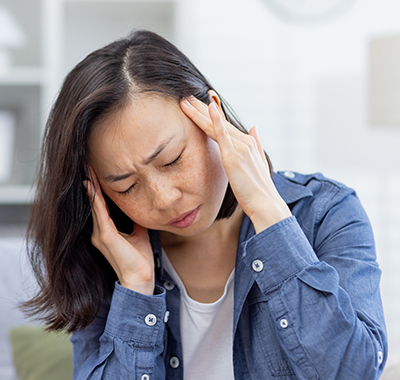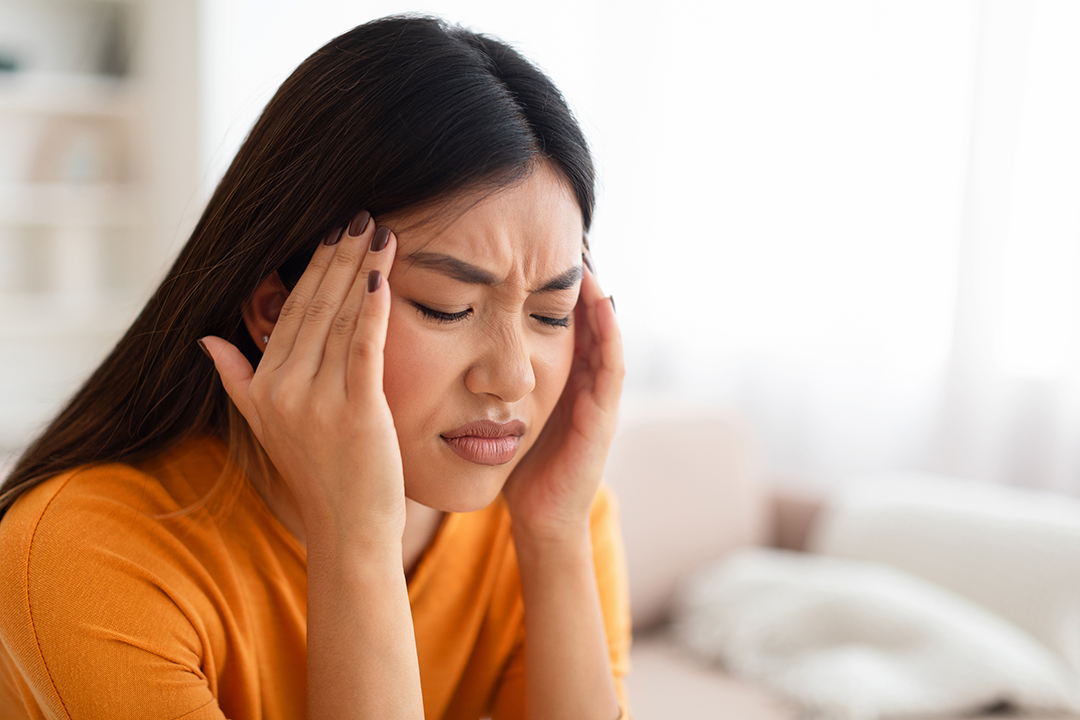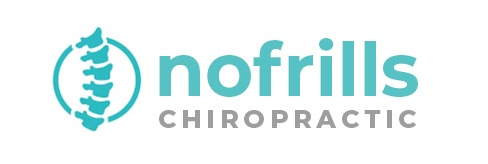Migraine: Causes, signs & how to relieve it
Read on to discover effective strategies and alternative treatments to tackle intense, localised migraines.

About Migraines
MIGRAINE SYMPTOMS
Do I experience migraines?
Intense, throbbing pain
Concentrated pain in a specific area
Frequent recurrence
The International Headache Society has established a straightforward “5-4-3-2-1” approach for diagnosing migraines without vision impairment:
5 or more attacks, lasting 4 hours to 3 days
A headache with at least 2 of the following:
- Unilateral location (on one side)
- Pulsating quality
- Moderate to severe pain worsened by activity
1 additional symptom during the headache:
- Vomiting and/or nausea
- Sensitivity to light and/or sound
DIFFERENT TYPE OF PAINS
Migraines vs Headaches
Migraines
Pulsating or Throbbing Sensations
Migraine pain is frequently characterized by a pulsating or throbbing sensation, resulting in significant discomfort.
Unilateral Head Pain
Migraines typically impact one side of the head, although this side may vary between different episodes.
Substantial Disruption to Daily Activities
Migraines are well-known for their disruptive impact on daily life. During an episode, individuals often encounter challenges in performing routine tasks or work.
Nausea, Potentially Leading to Vomiting
Nausea commonly accompanies migraines and may escalate to vomiting. This gastrointestinal disturbance can contribute to the overall discomfort.
Visual Disturbances (Aura)
Some individuals with migraines may experience visual disruptions known as auras, which can include seeing flashing lights, zigzag patterns, or, in severe cases, temporary blindness.
Increased Sensitivity to Light and/or Sound
Heightened sensory sensitivity is a characteristic feature of migraines. Individuals experiencing migraines often find that bright lights and loud sounds amplify their discomfort.
Tension Headaches
Mild to Moderate, Aching Discomfort
Tension headaches typically entail a consistent, dull ache rather than pulsating, throbbing pains associated with migraines.
Bilateral Head Pain
Tension headaches typically impact both sides of the head and are often described as a tight band or pressure around the head.
Limited Impact on Daily Activities
While tension headaches can be uncomfortable, they generally do not incapacitate individuals to the extent that migraines do. Most people can continue with their daily routines despite the discomfort.
Nausea is Uncommon
Nausea and vomiting are not usual symptoms of tension headaches.
Increased Sensitivity to Light and/or Sound
Sensory sensitivity is a characteristic feature of migraines. Individuals with migraines often find bright lights and loud sounds intensify their discomfort.
Heightened Sensitivity to Light and/or Sound
Sensory sensitivity is a hallmark of migraines. Individuals with migraines often find bright lights and loud sounds exacerbate their discomfort.
IDENTIFYING MIGRAINES
Migraine Phases
Prodromal Phase of a Migraine (also known as "the warning stage")
During this stage, various early warning signs may appear, such as neck stiffness, irritability, depression, lethargy, mood changes, and constipation.
Aura Phase of a Migraine (also known as "the hallucination stage")
This phase often involves visual disturbances, with possible experiences of tunnel vision, flashes of light, black dots, hallucinations, or, in severe cases, temporary blindness. Additionally, you may encounter auditory symptoms like ringing in your ears, tingling sensations, or difficulty speaking.
Attack Phase of a Migraine
The onset of a migraine may start with mild discomfort but will escalate into a throbbing pain on one side of your head. It tends to worsen with physical activity and can persist for a few hours to a couple of days.
Postdromal Phase of a Migraine
After the attack, you may undergo extreme exhaustion or a sense of euphoria, having successfully navigated through another migraine episode!

FACTORS CONTRIBUTING TO MIGRAINE RISK
Who is susceptible to experiencing migraines?
Although the precise cause of migraines remains elusive, various triggers can incite them. These triggers encompass:
Hormonal fluctuations (e.g., pregnancy, menstruation, ovulation)
Stress Dietary changes Consumption of foods high in caffeine, MSG, or nitrates
Environmental factors (e.g., loud noises, bright lights, strong odors)
Altered sleep patterns Medications

THE ROLE OF CHIROPRACTIC CARE IN ALLEVIATING MIGRAINES
How does chiropractic aid in reducing migraines?
Alleviating migraines through chiropractic care
Chiropractic care is a comprehensive approach to health that concentrates on the musculoskeletal system, particularly the spine. It operates on the principle that proper alignment of the spine can positively influence overall well-being. So, how does this pertain to migraines?
Probable cause - neck & upper back tension
Migraines are intricate and can stem from various triggers, but one common factor is tension in the neck and upper back. Stress, poor posture, and misalignment of the cervical spine (neck) can all contribute to this tension.
The efficacy of chiropractic adjustments
Chiropractors are adept at pinpointing misalignments in the spine and executing precise adjustments to rectify them. Concerning migraines, they focus on the cervical spine. Through gentle manipulation of the vertebrae in your neck and upper back, chiropractors can alleviate tension and reinstate proper alignment.

CHIROPRACTIC SOLUTIONS
Key areas of improvement through chiropractic care
Chiropractors utilize various chiropractic adjustment techniques to effectively manage lower back pain and enhance spinal health. Discover some of the most common chiropractic techniques used for lower back pain relief:
Spinal Manupilation
Chiropractic adjustments can alleviate muscle tension in the neck and upper back, often a contributing factor to migraine episodes.
Sacro-Occipital Technique (SOT):
The spine houses the central nervous system, which controls various bodily functions, including pain perception. Chiropractic care aims to optimize nervous system function, potentially decreasing migraine-related pain.
Activator Technique
Proper spinal alignment can enhance blood circulation, including to the brain. Improved blood flow may reduce the frequency and severity of migraines.
Flexion-Distraction Technique
Chiropractic care offers a non-invasive, drug-free alternative for migraine management, appealing to individuals seeking natural remedies.
CHIROPRACTIC CARE
What to expect from chiropractic care
Personalized Care
Chiropractic care is highly individualized. Your chiropractor will assess your specific condition, considering your medical history and lifestyle, tailoring the treatment plan to address your unique needs.
Combination Therapy
Chiropractic care can complement other migraine management strategies. Some individuals find relief by combining chiropractic adjustments with dietary modifications, stress reduction techniques, and relaxation exercises.
Consulting a Chiropractor
If migraines disrupt your life, consulting a chiropractor specializing in migraine management is wise. They will conduct a thorough evaluation to determine if chiropractic care is suitable for you.

BOOK AN APPOINTMENT
When to schedule a check-up for migraines
If migraines persist for more than a few days without improvement from home remedies or medications, scheduling a check-up is advisable.
Addressing the root cause is essential NoFrills Chiropractic, our chiropractors specialize in identifying if spinal misalignment contributes to migraines and can provide tailored recommendations.
Discover relief from migraines at NoFrills Chiropractic.
Contact us today to start your journey towards effective migraine management!
Book your initial chiropractic visit
hello@nofrillschiropractic.com
Phone
9007 1085
Open Hours
Mondays - Sundays: 9am-6pm
We're here whenever you need us
hello@nofrillschiropractic.com
Contact Us
9007 1085
Open Hours
Monday-Sundays:
10am to 7pm
Address
279 Tanjong Katong Rd
S437062
